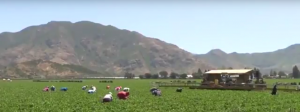The United States is experiencing the highest inflation in 40 years. One of the few causes that has dominoed into hikes in inflation is the decrease in migrant labor in the U.S.
According to a source from Fortune Magazine, there are 2 million fewer immigrant laborers in the United States.
“These 2 million missing immigrants are part of the reason we have a labor shortage,” shares Giovanni Peri, an economist at the University of California, Davis.
Peri notes, too, that consumers will meet these labor shortages by paying higher prices for goods. Peri predicts that we will see an increase in wages to attract folks to traditionally low-paying, high-laborious jobs.
For every 100 immigrant workers in the U.S, there are 2.7 immigrants employed in agriculture, according to the U.S. Bureau of Labor Statistics. That is more than double the amount of people in agriculture that are native born. And the numbers have decreased as a result of COVID-19 and increased immigration policies.

It’s an unfortunate outcome, in and out of our control as a country. I say “out of our control” because the last two years of COVID has alerted the country to invasive antigens and variants from people coming into the country. The U.S. has put in extensive measures to prevent immigrants from entering the country and, almost over a year later, adding new expectations for testing to be allowed in. This has slowed the labor force and brought the number of laborers down hundreds of thousands of people.
What’s in our control? Policies that allow immigrant laborers to work in the country.
“This decline [in immigrant labor] reflects both tougher immigration policies and the pandemic which reduced legal immigration and caused some recent immigrants to return to their native countries,” David Kelly, chief global strategist at JPMorgan Funds.
President Joe Biden addressed the lack of incentive for immigrant workers to jump back into the U.S. labor force in his May 31, 2022, statement:
“My Administration is committed to ensuring that our immigration system is accessible and humane. I have called on the Congress to pass long-overdue legislation to comprehensively reform our immigration system. Through multiple Executive Orders, I have also directed agencies across the Federal Government to remove barriers that improperly impede access to immigration benefits and to assure fair and timely adjudication of those benefits.”
The White House can look into increasing benefits for immigrants seeking work in the U.S., and we can increase wages — but does that really solve the issue?
There is still a decrease in birth rates in the U.S., which will lead to a huge fight between industries to secure laborers — native or immigrant — in the future. Most laborious fields, like agriculture, rarely see a growth in employee numbers with an increase in wages as the task is still daunting for many native workers. And many jobs require more than a high school diploma, but the cost of attending school is egregiously high.

The U.S, especially industries like agriculture that are very laborious, has two paths forward. One, partially or fully atomizing the industry. Two, lobbying alongside immigrant labor unions to amend immigration policies and immigrant labor policies that allow easier access to our country and the hundreds of thousands of jobs that are going unfilled; stalling our national supply of goods across industries (such as textile, food, etc.).
So, what are those immigration policies halting immigration labor and amnesty?
The entirety of the policies aren’t the issue. In fact, policies such as the Immigration and Nationality Act (INA) of 1952 or the clause within the act speaking specifically to “special agriculture workers” have taken many years and many edits to arrive where the legislation stands today. However, there are still places within the legislation that can be amended to allow easier access to our country and its labor to help us as a nation get back on track and to see more of our prices at the store decrease.
As everyday citizens, consumers, and/or agriculturalists, we can engage in this work. We don’t need to be the people in the game, shuffling through legislatures offices and having meetings. We can support, monetarily or in our own meetings with lobbying organizations, to share our perspectives either for or against some immigration policies. Why? This because conversations around these issues from all our varying perspectives is what will springboard us all to a more inclusive, equitable, and positive space. It takes all kinds of kinds in an argument or an issue to arrive at a better tomorrow.
Where will you be in these next few months to help resolve the growing labor shortage in our country that is contributing to a rise in inflation? Is there something we can be doing, rather than watching as the price for goods rises? Where do we fall in the challenges that a decrease in labor has caused our country?
Bre Holbert is a past National FFA President and studies agriculture science and education at California State-Chico. “Two ears to listen is better than one mouth to speak. Two ears allow us to affirm more people, rather than letting our mouth loose to damage people’s story by speaking on behalf of others.”



